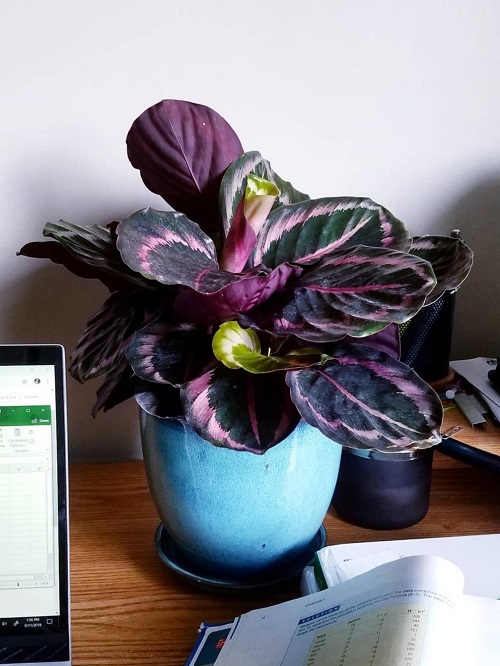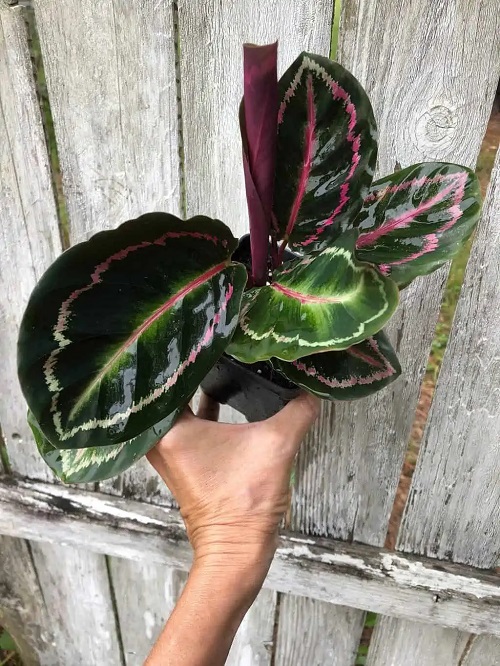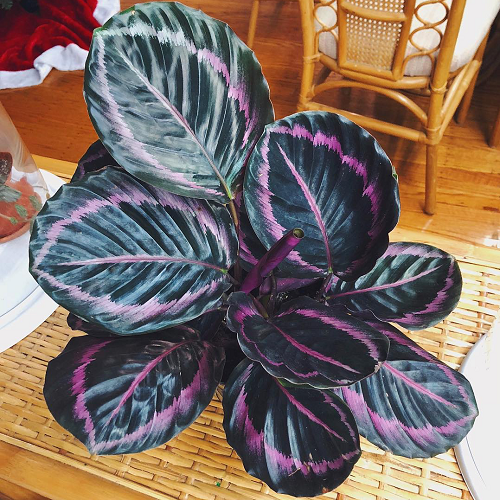Discover How to Grow Calathea Roseopicta with this easy-to-follow guide. Learn all the essentials for successful planting in simple steps.

Learn the secrets to successfully growing Calathea Roseopicta with our comprehensive guide. Find the essential steps and tips for optimal growth and care.
Read Calathea Orbifolia Care and Growing Guide here
Calathea Roseopicta Information
The Calathea roseopicta, also known as the Rose-Painted Calathea, lives up to its name with its stunning features. Its large leaves display a captivating combination of rose-colored outlines and deep green fillings. At night, when the leaves fold up, the vibrant red-purple undersides become more prominent, adding to its allure.
Originating from Brazil, it belongs to the prayer plant family. The upward-facing, prayer-like positioning of the leaves further enhances its tropical charm, making it a delightful addition to the indoor space.
Read Calathea Leaves Turning Brown and Yellow Solutions here
Propagating Calathea Roseopicta
The best way to Propagate Calathea Roseopicta is through division; follow these steps:
- Select a healthy, disease-free parent plant and unpot it gently without hurting the roots.
- Examine the plant’s root ball and locate natural divisions or separate clusters of roots.
- Using your fingers, gently work the roots apart at these natural divisions, taking care not to break them. Be gentle and patient during this process.
- Unless the plant is large enough to create additional divisions, it is generally recommended to divide it into two sections. This helps minimize stress on the plant.
- Place each division into individual pots and fill them with soil, ensuring that the root is slightly submerged in the soil.
- After planting, thoroughly water the divisions and cover the pot with a clear plastic bag to create a greenhouse effect. This helps retain heat and humidity, which is beneficial for their growth.
- Place the pots in a location with bright, indirect sunlight.
Remove the plastic bag once new growth appears, which will take 14-20 days. Once they do, provide them with appropriate care to help the new plants thrive.
Check out 45 Fussy But Fabulous Calatheas You Need To See here
Requirements for Growing Calathea Roseopicta
Location
Calathea roseopicta thrives in well-lit areas with a balance of brightness and shade, resembling its natural habitat. It benefits from abundant indirect light but should be shielded from direct sunlight.
Placing the plant near a north or east-facing window for optimal light exposure. Do ensure not to expose it to direct sun exposure as that will scorch the leaf edges and fade its color.
Soil
To provide an optimal growing medium for Calathea roseopicta, select a lightweight and well-draining mix that effectively retains moisture. A recommended mixture is a combination of two parts, peat or coco coir and one part perlite, as it offers both adequate drainage and moisture retention.
While commercial houseplant potting mixes can be used, it is advisable to supplement them with perlite or a similar drainage amendment to improve drainage capabilities.
Water
Maintaining consistent moisture is vital for the well-being of Calathea roseopicta, making regular watering a crucial part of its care routine. Water the plant when the top 1-2 inches of soil has dried out, using low-lime water such as rainwater for optimal results.
Avoid leaving the plant in standing water, and after watering, be sure to remove any excess water that accumulates in the bottom pot tray after about 15 minutes.
During the winter months, when temperatures are lower and daylight is reduced, water Calathea roseopicta less frequently. However, ensure to prevent the root ball from completely drying out.
Temperature and Humidity
It is crucial to maintain a consistent temperature range between 65-85°F (18°C to 29°C) throughout the year.
During the winter months, prevent the temperature from dropping below 59°F (15°C), as this can negatively impact the plant’s growth. You can keep the plant in a greenhouse or induce heat lamps to keep the temperature under control.
Calathea roseopicta also requires a high level of humidity. You can achieve this by placing the plant in areas with naturally high moisture levels, such as a bathroom.
Additionally, a practical method to increase humidity around your Calathea roseopicta is to place its pot on a saucer filled with pebbles and water. This allows water to evaporate, creating a moist and humid environment that is beneficial for the plant’s thriving.
Discover 19 Best Calathea Types here
Calathea Roseopicta Care

Fertilizer
Calathea roseopicta does not require excessive feeding, but it can benefit from regular and light fertilization during its active growth period. Opting for organic fertilizers is advisable as they are gentle and do not harm the plant’s delicate roots.
To provide the plant with the necessary nutrients, use a balanced, water-soluble fertilizer. Dilute the fertilizer to 1/4 of the recommended strength and apply it once a month from spring through fall. Refrain from fertilizing during the winter months when the growth slows down.
Follow the instructions provided on the fertilizer packaging carefully and avoid excessive fertilization, as this can result in root burn and other complications.
Pruning
To maintain the health and appearance of your Calathea roseopicta, it’s important to remove any brown, yellowing, or damaged leaves. Simply cut them near the base, close to the main stem. Before and after using your tools, remember to sterilize them with rubbing alcohol. Regular maintenance will encourage healthy growth and help your plant maintain a neat appearance.
Re-potting
When it comes to repotting Calathea roseopicta, you must handle the process with care to minimize stress on the plant. While some plants can go for years without needing to be repotted, the Rose Painted Calathea may require fresh soil or a larger container approximately every 1-2 years.
If you notice slow growth in your plant, it could be an indication that repotting is necessary. When repotting, it’s best to avoid excessive disturbance to the roots. Lightly pat down the soil to maintain its fluffiness and provide stability. When selecting a new pot, avoid choosing one that is more than 1 inch larger in size compared to the previous container.
Pests and Diseases
Calathea roseopicta is prone to various pests, including mealybugs, spider mites, thrips, aphids, and whiteflies.
If you observe any signs of infestation, it is crucial to take immediate action. Treat the affected plant with neem oil or insecticidal soap to combat the pests effectively. It is also advisable to isolate the infested plant to prevent the pests from spreading to other plants in your collection.
Fungal diseases, such as powdery mildew, leaf spot, fungal root decay, and white soil mold, can also affect Calathea roseopicta. To prevent these diseases, maintain proper watering practices, ensure adequate airflow around the plant, and provide suitable temperatures. In case of fungal infection occurs, apply a fungicide following the instructions on the label to address the issue effectively.


